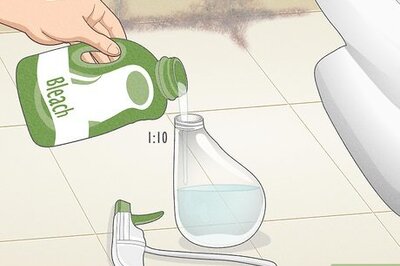
views

Purchase the supplies you need. Glass paint for small art projects like painting designs on wine glasses, mugs, and cups can be acquired at most local arts and crafts stores. Easy to use oven curing glass paint is best for small artistic glass painting projects. Pebeo glass paints work well for small artistic glass painting applications. These paints are inexpensive and are widely available in small bottles, paint pens, and markers. Small projects, like those listed above, can be performed at home with minimal supplies. General supplies needed include: Glass paint Artistic paint brushes Paper towels Small work table

Be aware that glass paint for architectural glass and interior design such as; colored glass back splashes, colored glass tables, colored glass counter tops, colored glass walls, colored spandrel glass for buildings etc., is much more complex. It requires permanent bonding. These paints must resist various weather conditions, UV rays, temperature fluctuation, mineral deposits, chemicals, cleaners, and more. There are a small group of companies who offer finished “back painted glass” for the glass industry. Most of these companies are located outside the USA such as Decoglaze Glass Splashbacks in Australia and Glass Kitchen Splashbacks in the United Kingdom. Back painted glass is also available in the USA through companies that use glass paint with permanent glass surface bonding properties. Some companies use a large format oven baking process to bond specialty powder coat paints to glass, others use specialty foreign glass paints combined with heat lamps for curing.

Understand nanotechnology paint properties. The most advanced glass paints available today are formulated with an active glass surface molecular modifying technology better known as “nanotechnology”. This technology ensures a true permanent glass bond in one easy step. These paints can easily be sprayed or rolled on any glass surface and cured at room temperature. In the USA, glass paint such as self priming glass paint contains this nanotechnology.

Take care when painting glass. Painting glass for the above applications requires more stringent handling and application procedures. These paints have solvent based organic odors that should not be inhaled and require ventilation and the use of organic filtered half face respirators. Air supplied hoods need to be used if you must work in an area with low ventilation. Solvent resistant gloves and full body Tyvek suits should also be worn when painting to avoid over exposure. Glass can be painted in almost any location such as outdoors, in paint booths, in garages, and really anywhere that you can stand up a piece of glass. A good method for painting glass on-site is to wet the surrounding floor and walls with water from a hose. This will hold down any dust that could cause a problem while painting.

Know what supplies are needed for spraying glass paint. They include: Permanent bonding glass paint Paint mixing cup Disposable paint filter screens Proper respirator Gloves Tyvek suit HVLP spray paint gun Air filter Air compressor Acetone Paper towels Rubbing alcohol

Know the general supplies needed for rolling on glass paint: Permanent bonding glass paint Conventional paint roller Paint roller tray Acetone Paint mixing cup




















Comments
0 comment